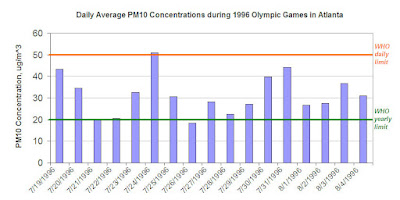Two days ago, the US House passed a broad
resolution urging China "to immediately end abuses of the human rights of its citizens, to cease repression of Tibetan and Uighur people, and to end its support for the Governments of Sudan and Burma."
Perhaps surprisingly, this action by the House was reported in the Chinese media. But I think there is a lot to be learned from examining exactly how it was reported. I'll reference
this China Daily article as a typical case.
First of all, to understand how the Chinese media reported this event, we have to ignore the actual content of the resolution, because, as one would expect, the content itself was never discussed. What
was discussed in the Chinese media, however, was the basic fact that the House said something negative about China in advance of the Olympics.
Some key sentences of the China Daily article that stood out to me:
"The passing of the resolution at this time has fully exposed the attempt of the very few anti-China US lawmakers to politicize the Olympics and their evil intention to disrupt and sabotage the Beijing Olympic Games," said the official.
"Such a deed has violated the Olympic spirit and aim, and also violated the common wish of the world people, including the US people," said the official.
Magically, the resolution now has nothing to do with human rights, and everything to do with "evil" attempts to "sabotage" the peaceful and harmonious Olympics. Who would dare do such a thing? And not only that, these views (supposedly) aren't even shared by the American people!
There are at least two tactics here that probably could be taught in PR classes.
First, the content of the resolution is discredited as being from a fringe group of China-haters who do not represent the majority opinion. (The article conveniently fails to mention that the resolution passed 419-1.) Therefore, the content isn't even worth spending time reviewing.
Second, the dialogue in China has been successfully deflected away from China's human rights record and onto the supposedly unfounded, unfaltering, unfair criticism so often levied by foreigners on China. This, of course, ultimately bolsters nationalism with an "us vs. them" attitude.
Similar tactics were employed by the Chinese media during the Tibet uprising in March of this year, especially with regard to CNN's biased reporting:
Chinese netizens, including students studying overseas, have been angered by biased and sometimes dishonest reports about the recent riots in Tibet by some Western media.
Another article described a "wave of anger and patriotism generated by CNN's recent offensive coverage of China."
Again, the two-fold tactic is to discredit the source and then use supposed foreign bias to fuel nationalism.
I may be getting too far off course here by linking the House resolution to foreign media coverage of China, but I think a common and important theme is that statements and reports by foreigners often have unexpected and/or undesired impacts within China. With regard to the House resolution specifically, I think Americans need to be very clear that actions like this a) have a completely different tone within China than they do outside of these borders; b) probably affect little or no actual change; and c) may ultimately have precisely the wrong impact if they only serve to hinder future trust and communication.























